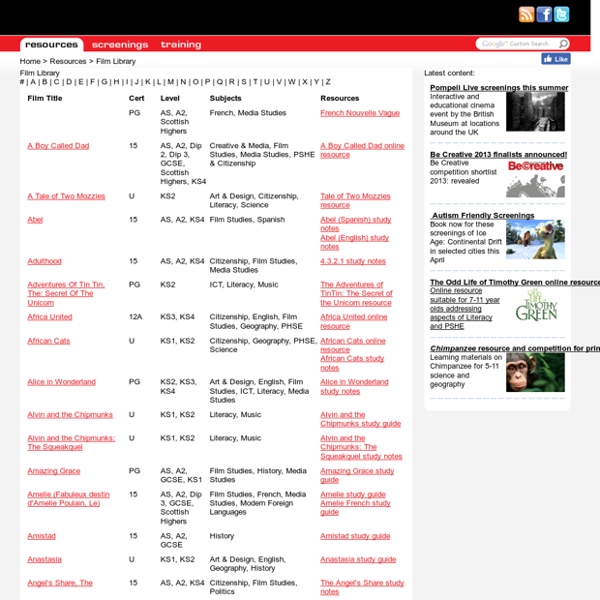Film Education | Home
Welcome to Literacyhead!
Writing Objectives Using Bloom's Taxonomy | Center for Teaching & Learning
Various researchers have summarized how to use Bloom’s Taxonomy. Following are four interpretations that you can use as guides in helping to write objectives using Bloom’s Taxonomy. From: KC Metro [old link, no longer functioning?] Bloom’s Taxonomy divides the way people learn into three domains. One of these is the cognitive domain, which emphasizes intellectual outcomes. This domain is further divided into categories or levels. From: UMUC From: Stewards Task Oriented Question Construction Wheel Based on Bloom’s Taxonomy Task Oriented Question Construction Wheel Based on Bloom’s Taxonomy. ©2001 St. From: GA Tech According to Benjamin Bloom, and his colleagues, there are six levels of cognition: Ideally, each of these levels should be covered in each course and, thus, at least one objective should be written for each level. Below are examples of objectives written for each level of Bloom’s Taxonomy and activities and assessment tools based on those objectives.
The Visual Leap - About Visual Thinking
>> Home • About Visual Thinking About Visual Thinking Visual thinking, also called visual learning, is a proven method of organizing ideas graphically - with concept maps, mind maps and webs. Scientifically based research demonstrates that visual learning techniques improve memory, organization, critical thinking and planning. Visual thinking is an intuitive and easy-to-learn strategy that works for many academic and professional projects. Visual Leap programs use visual thinking software as a learning tool, and this software accelerates the learning process. According to studies conducted by the Institute for the Advancement of Research in Education, visual learning techniques improve: Test scores Writing Proficiency Long-term Retention Reading Comprehension Thinking and Learning Skills Visual thinking is intuitive. Visual thinking is easy to learn. Joseph D. 37% of people are visual-spatial learners. The Visual Leap will help you harness this asset.
Home - Visual Thinking Strategies
60 Small Ways to Improve Your Life in the Next 100 Days
Contrary to popular belief, you don’t have to make drastic changes in order to notice an improvement in the quality of your life. At the same time, you don’t need to wait a long time in order to see the measurable results that come from taking positive action. All you have to do is take small steps, and take them consistently, for a period of 100 days. Below you’ll find 60 small ways to improve all areas of your life in the next 100 days. Home 1. Day 1: Declutter MagazinesDay 2: Declutter DVD’sDay 3: Declutter booksDay 4: Declutter kitchen appliances 2. If you take it out, put it back.If you open it, close it.If you throw it down, pick it up.If you take it off, hang it up. 3. A burnt light bulb that needs to be changed.A button that’s missing on your favorite shirt.The fact that every time you open your top kitchen cabinet all of the plastic food containers fall out. Happiness 4. 5. 6. How many times do you beat yourself up during the day? 7. Learning/Personal Development 8. 9. 10. 11. 12. 13.
Close Reading: The Text, the Students, and Me
Close Reading: The Text, the Students, and Me By Sarah Powley closeAuthor: Sarah Powley Name: Sarah PowleySite: n English teacher for 37 years, Sarah has taught in secondary schools in Wisconsin, Connecticut, and Indiana. For many years, she served as the English Department Chair at McCutcheon High School in Lafayette, Indiana, and is now a full-time Instructional Coach for her district. Honors include the Milken National Educator Award, the Eli Lilly Teacher Creativity Fellowship, the Irena Sendler Award for Holocaust Education, and Purdue University's Crystal Apple Award.See Authors Posts (18)“Mrs. Powley! I sometimes heard that question when I was the teacher at the front of the room, leading my students through Great Expectations, Huckleberry Finn, To Kill a Mockingbird, The Great Gatsby…and a library of other literary staples in the English Language Arts canon. “I’ll never be able to read a book like that,” they would say. About the author
Teaching Middle School Language Arts
Go Back: Virtual Middle School Library Home / Resources for Teachers and Parents Menu / Language Arts Menu for this page: General Language Arts | Literature and Reading | Writing | Worksheets and Online Games General Language Arts Web English Teacher - Very extensive guide to language arts sites and lesson plans. Literature and Reading Read, Write, Think - Lesson plans for language arts from the International Reading Association and the National Council of Teachers of English. Literature and Language Arts - Lesson plans from EdSiteMent. Media Literacy Teaching Media Literacy - Lesson plans from the National Council of Teachers of English. Writing Language Arts Lesson Plans - From Teachnology. 30 Ideas for Teaching Writing - From the National Writing Project. Writing Bugs - Ideas for topics for students to write about. Worksheets and Online Games Language Arts Worksheets - For all grades from Education World. This site is maintained by Linda Bertland, retired school librarian.



